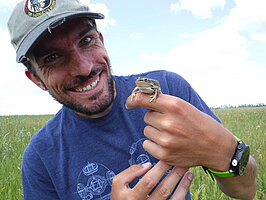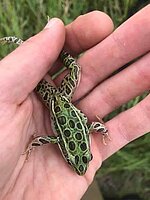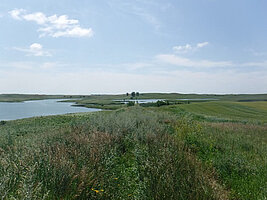Natural and Anthropogenic Landscape Effects on Amphibians in the Northern Great Plains: Genetic Population Structure, Connectivity, and Local Adaptation in Northern Leopard Frog (Rana Pipiens)

Justin Waraniak, a PhD student in the Environmental and Conservation Sciences Program with a concentration in Conservation Biology at North Dakota State University. I specialize in population genetics and community ecology with a particular focus on aquatic organisms including fishes and herpetofauna. I graduated from the University of Michigan with a Bachelors of Science in Ecology and Evolutionary Biology and a minor in Asian Language (Mandarin Chinese) in 2014 and completed my Masters of Science in Fisheries and Wildlife with a concentration in Ecology, Evolutionary Biology and Behavior from Michigan State University in 2017.
Natural and anthropogenic landscape effects on amphibians in the northern Great Plains: Genetic population structure, connectivity, and local adaptation in northern leopard frog (Rana pipiens)
Research Abstract
The northern leopard frog, though common in North Dakota, has become imperiled throughout the western portion of its range due to climatic stressors and loss of habitat from land-use change. Agricultural land use has greatly expanded in the northern Great Plains and is continuing to replace natural prairie and wetlands on the landscape. In addition to replacing habitat, agriculture can introduce new stressors into remaining wetland habitats in the form of nutrient loading from fertilizers or toxicity from pesticides. In experimental settings, high concentrations of agricultural pollutants are known to have negative effects on wetland-dependent taxa, including amphibians, however little work has been done to identify population-level effects in real-world systems. Modern SNP-based molecular-genetics techniques allow insights on how anthropogenic land use patterns influence genetic variation in northern leopard fog populations. Land use patterns may affect biotic connectivity as well as fine scale genetic variation. These markers can reveal evidence for selection in leopard frog populations from wetlands impacted by varying degrees and types of agriculture. When combined with landscape data, the genetic information can be used to develop a model of connectivity to identify focal wetlands and critical habitat for management and conservation. Additionally, scanning for associations between genomic data and agricultural intensity can reveal insights into selective pressures faced by amphibians in an agriculture-dominated landscape.
Research Highlight
We collected northern leopard frogs from 28 samples sites (20 frogs per site) in the Lake Oahe and James River basins for genomic analysis. After quality filtering of genomic data, frogs were genotyped at over 2400 biallelic SNP (single nucleotide polymorphism) loci. Initial analyses indicated that there was no obvious effect of the amount of nearby agriculture on the measures of genetic diversity, as the pro-portion of land use for cultivated crops in a 5-km buffer around the sample site wet-land did not explain a significant amount of variation in estimates of heterozygosity or inbreeding coefficients. However, analyses of genetic connectivity among our sites suggest that agricultural areas may be acting as a barrier to movement for frogs. This analysis suggests that areas of interconnected grassland and wetland are necessary to maintain biological connectivity in the Prairie Pothole ecosystem. Additionally, the habitat suitability models were updated by using the land use data from 2019 and the occurrence of five anuran species was predicted for the study area near Jamestown, ND. Despite the increases in agricultural land use (particularly corn and soy-beans) in the study area, several species were expected to expand their range since 2010 due to the increased amount of water on the landscape. Field work should be conducted in the future to test the results of this habitat suitability model.



Craig Stockwell
Biological Sciences
Office: Stevens 119
Telephone: 701-231-8449 Email: craig.stockwell@ndsu.edu

David Mushet
Chief-Climate and Land Use BranchAgicultural and Biosystems Engineering
USGS


